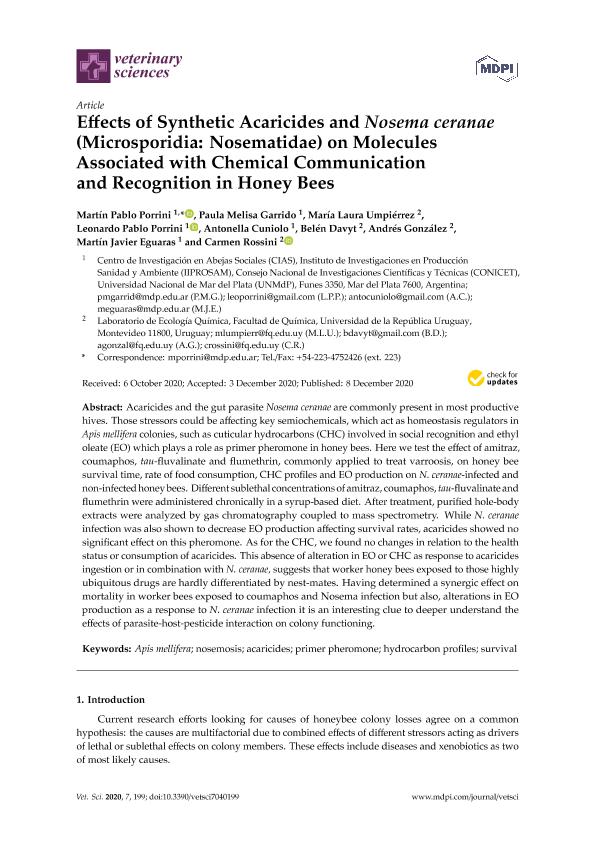Artículo
Effects of Synthetic Acaricides and Nosema ceranae (Microsporidia: Nosematidae) on Molecules Associated with Chemical Communication and Recognition in Honey Bees
Porrini, Martín Pablo ; Garrido, Paula Melisa
; Garrido, Paula Melisa ; Umpiérrez, María Laura; Porrini, Leonardo Pablo
; Umpiérrez, María Laura; Porrini, Leonardo Pablo ; Cuniolo, Antonella
; Cuniolo, Antonella ; Davyt, Belén; González, Andrés; Eguaras, Martin Javier
; Davyt, Belén; González, Andrés; Eguaras, Martin Javier ; Rossini, Carmen
; Rossini, Carmen
 ; Garrido, Paula Melisa
; Garrido, Paula Melisa ; Umpiérrez, María Laura; Porrini, Leonardo Pablo
; Umpiérrez, María Laura; Porrini, Leonardo Pablo ; Cuniolo, Antonella
; Cuniolo, Antonella ; Davyt, Belén; González, Andrés; Eguaras, Martin Javier
; Davyt, Belén; González, Andrés; Eguaras, Martin Javier ; Rossini, Carmen
; Rossini, Carmen
Fecha de publicación:
12/2020
Editorial:
MDPI
Revista:
Veterinary Sciences
ISSN:
2306-7381
Idioma:
Inglés
Tipo de recurso:
Artículo publicado
Clasificación temática:
Resumen
Acaricides and the gut parasite Nosema ceranae are commonly present in most productivehives. Those stressors could be affecting key semiochemicals, which act as homeostasis regulators inApis mellifera colonies, such as cuticular hydrocarbons (CHC) involved in social recognition and ethyloleate (EO) which plays a role as primer pheromone in honey bees. Here we test the effect of amitraz,coumaphos, tau-fluvalinate and flumethrin, commonly applied to treat varroosis, on honey beesurvival time, rate of food consumption, CHC profiles and EO production on N. ceranae-infected andnon-infected honey bees. Different sublethal concentrations of amitraz, coumaphos, tau-fluvalinate andflumethrin were administered chronically in a syrup-based diet. After treatment, purified hole-bodyextracts were analyzed by gas chromatography coupled to mass spectrometry. While N. ceranaeinfection was also shown to decrease EO production affecting survival rates, acaricides showed nosignificant effect on this pheromone. As for the CHC, we found no changes in relation to the healthstatus or consumption of acaricides. This absence of alteration in EO or CHC as response to acaricidesingestion or in combination with N. ceranae, suggests that worker honey bees exposed to those highlyubiquitous drugs are hardly differentiated by nest-mates. Having determined a synergic effect onmortality in worker bees exposed to coumaphos and Nosema infection but also, alterations in EOproduction as a response to N. ceranae infection it is an interesting clue to deeper understand theeffects of parasite-host-pesticide interaction on colony functioning.
Palabras clave:
APIS MELLIFERA
,
NOSEMOSIS
,
ACARICIDES
,
PRIMER PHEROMONE
Archivos asociados
Licencia
Identificadores
Colecciones
Articulos(CCT - MAR DEL PLATA)
Articulos de CTRO.CIENTIFICO TECNOL.CONICET - MAR DEL PLATA
Articulos de CTRO.CIENTIFICO TECNOL.CONICET - MAR DEL PLATA
Citación
Porrini, Martín Pablo; Garrido, Paula Melisa; Umpiérrez, María Laura; Porrini, Leonardo Pablo; Cuniolo, Antonella; et al.; Effects of Synthetic Acaricides and Nosema ceranae (Microsporidia: Nosematidae) on Molecules Associated with Chemical Communication and Recognition in Honey Bees; MDPI; Veterinary Sciences; 7; 4; 12-2020; 1-18
Compartir
Altmétricas



